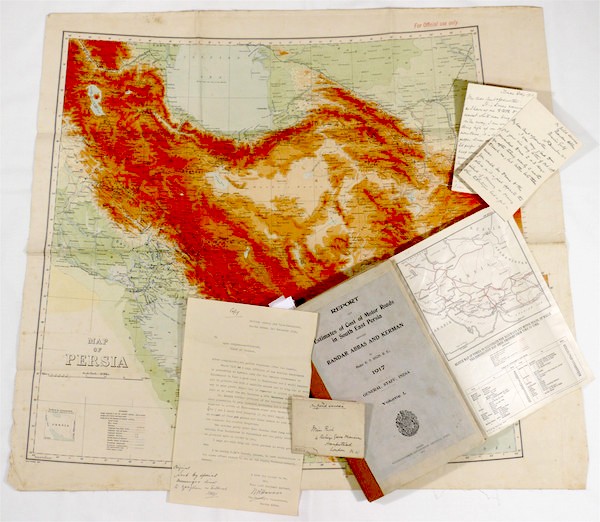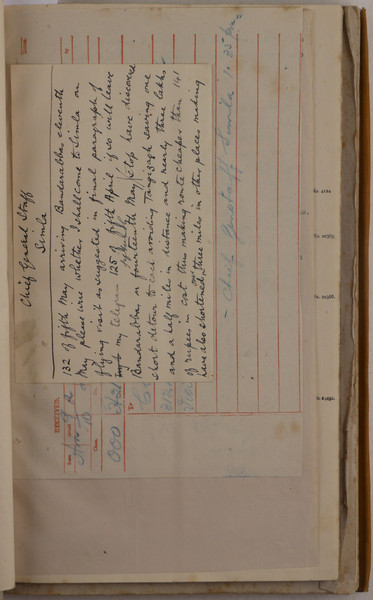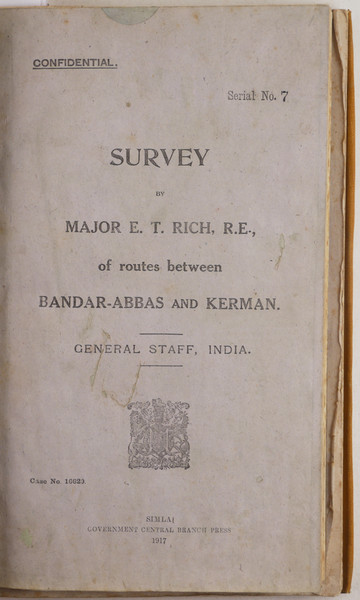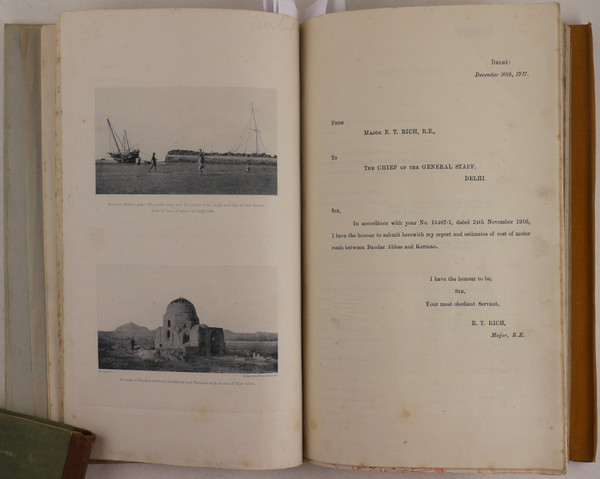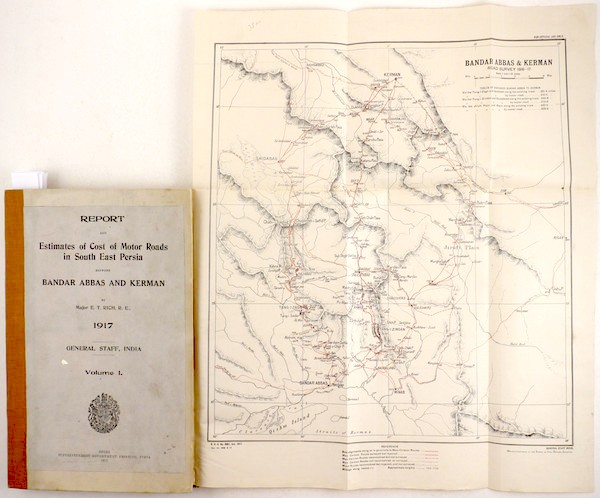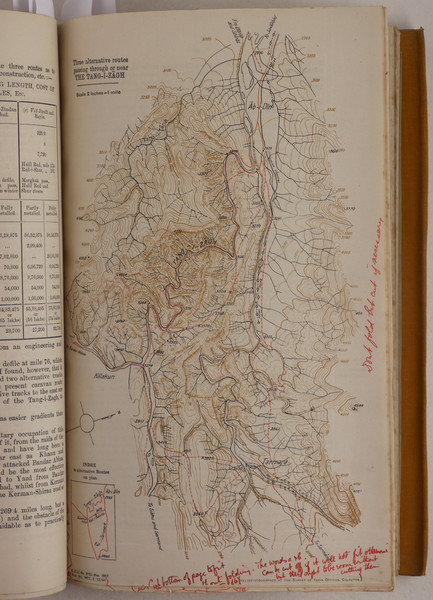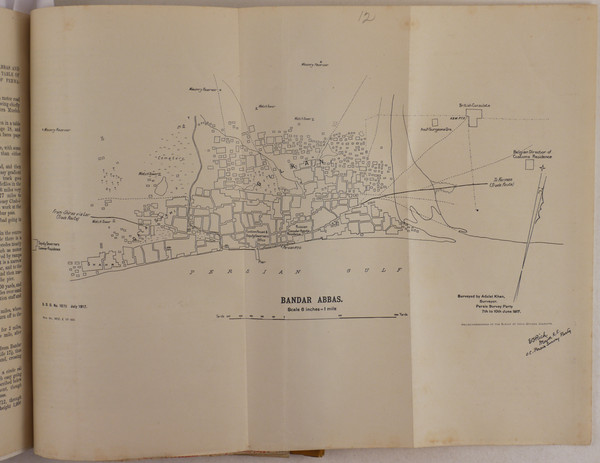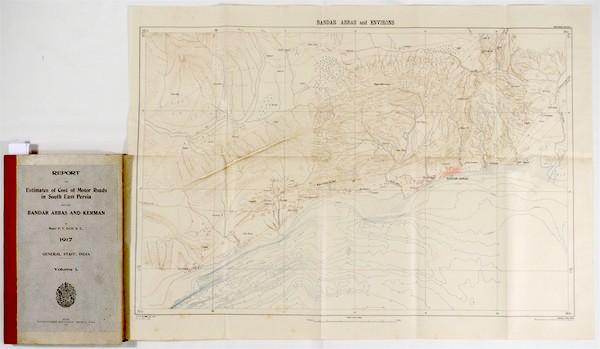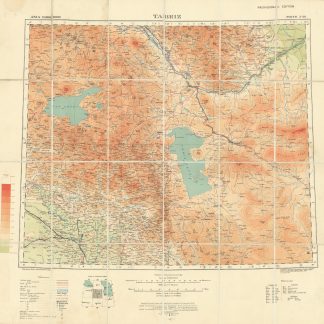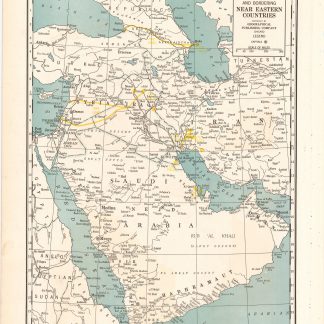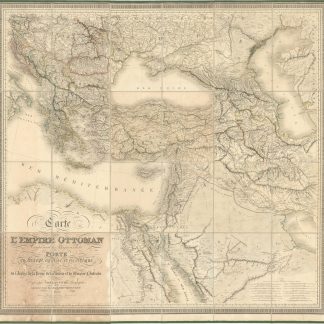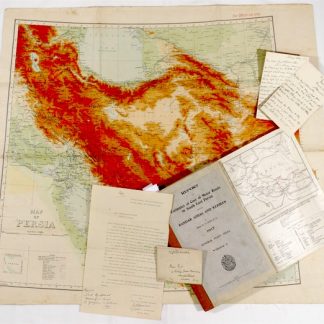Original Archive Road Survey Documents from the Persian Campaign of WWI
Report and Estimates of Cost of Motor Roads in South East Persia Between Bandar Abbas and Kerman.
Folio (218 x 340 mm). Two parts: 1) Confidential. Survey by Major E.T. Rich, R.E., of routes between Bandar-Abbas and Kerman. General Staff, India. Simla: Government Branch Press, 1917. 9, 13, (1), 7, 16 = 46 pp. With six maps and plans (two folding), a proof plate with 2 photo views, and 13 leaves of original manuscript, typewritten and printed telegrams related to the report. Both original publisher’s wrappers bound in.
2) Confidential. Report by Major E. T. Rich, R.E., on the Construction of Motor Roads in South Persia between Bandar Abbas and Kerman. 1917. General Staff, India. 2 vols. Delhi: Superintendent Government Printing, India, 1918. Vol. 1: (2), IV, 38 pp. With 12 leaves of plates (including one proof plate) and 8 maps and plans (3 folding). Vol. 2: 39-54 pp. With 3 folding maps. Occasional red ink notes by Rich in text and on the maps/plans; original publisher’s wrappers bound in. Occasional red ink notes by Rich in text and on the maps/plans; both original publisher’s wrappers bound in. Custom-made hardcover binding with the first publisher’s wrapper of the original report pasted to the front board. With a large folding linen backed map of Persia in the pocket at rear. Addenda (see below).
€ 12.500,00
Special custom-bound, historically important archive, compiled by E. T. Rich and containing confidential printed reports, 18 maps and plans, as well as original documents related to the survey of potential routes for a motor road between Bandar Abbas and Kerman in southern Persia. The survey was carried out by Rich as a part of the Persian campaign during the First World War on the special orders of the Chief of General Staff in India. As a part of WWI military operations, Bandar Abbas was occupied by British forces under command of Sir Percy Sykes in March 1916, and the survey was apparently undertaken in order to establish additional supply routes to the war’s Persian front. Rich was ordered "to report as soon as possible on the best route for a road to take motor lorry traffic from Bandar Abbas to Kerman and to frame estimates from the same and proposals as to the best way of carrying out the work." The survey was done between December 1916 and June 1917; a year later Rich was promoted a Companion of the Order of the Indian Empire (C.I.E.) for his work. Nevertheless, the road never was constructed, probably because of the cardinal changes on the Persian front after the collapse of the Russian front line as a result of the revolution in February 1917.
The volume contains: confidential reports by Rich; printed "Working notes" on the survey; maps and plans of Bandar Abbas, Kerman, and the area in between; telegrams sent to him from the Chief of General Staff (Delhi & Simla), Surveyor General’s Office in Calcutta, British Consul in Bandar Abbas; tables with distances and estimates of construction, printed views of the area et al. Several leaves slightly age-toned, but overall a very good custom-made copy.
Supplemented with Rich’s copy of a typewritten dispatch from the British Vice-Consul in Bandar Abbas to the Chief of Roodbar (South Persia) Zarghan-us-Saltaneh, dated Bandar Abbas, 2 Dec. 1916. In the dispatch the consul asks for the assistance to Rich who is going to visit the area under the chief’s control during the course of his road survey. The copy is signed by the consul and has his manuscript note "Original sent by special messenger direct to Zarghan-us-Saltaneh." - There are also two autograph signed letters by Rich, addressed to his aunt in London and written while on field service in Southern Persia. The letters are dated 10 & 25 Dec. 1916, housed in the original envelope with a postal stamp of Bandar Abbas, and contain interesting notes about Rich’s work and his observations on the native life. [Near Kerman:] "It is Xmas evening & as I have no one to talk to, the nearest white man being over 100 miles away, I am writing instead. Being high up over 5000 feet in the mountains, it is bitterly cold & proper Xmas weather, but personally I’d prefer it a bit warmer as I can’t keep warm no how at night which means continuously waking up [...] The food of the villagers about here is most strange, being dates & bread about 2 lbs of each per diem & nothing else. They feed the horses & cows on dates & even the dogs. I eat them once a day for lunch which consists of porridge, bread & cheese & dates. I often envy the meals my servants get at home when I am out on these expeditions." - E. T. Rich (1874-1937) was a British military engineer and surveyor, Fellow of the Royal Geographical Society. He graduated from Sandhurst with the Pollock Medal and was gazetted as 2nd Lieutenant in the Royal Engineers. In 1895 he went out to India and was posted to railway survey work in Burma. In 1905-1909 Rich worked as survey officer on the Indian North-West Frontier, and took part in the Bazar Valley and Mohmand Campaigns of 1908 (as a divisional and a chief survey officer respectively). During the latter he was slightly wounded and for his services was promoted brevet-major. In 1911 Rich was appointed the head of the survey office on the Burma frontier post at Myitkyina, where he carried out the survey of the border with Tibet and Yunnan. In 1916/17 he was in charge of the survey party looking for the alternative routes between Bandar Abbas and Kerman in South Persia; in 1918 he was in charge of the North West Persia Survey Detachment which accompanied British intervention in the Caspian under command of General Dunsterville. Rich carried out important surveys in Baku, Batum and Tiflis. After WWI Rich returned to Burma where he became the head of the Burma Circle of the Survey of India. In 1920-22 while surveying the unadministered territory between Burma and Assam he encountered slavery and human sacrifices still practiced there; in 1925 he took part in the Sir Harcourt Butler’s Mission to the Hukawng Valley to suppress slavery. Rich retired with the rank of Colonel and C.I.E. in 1929. "Colonel Rich was a great linguist, and besides his knowledge of Urdu, Pushtu, and Persian, he was able to converse in Yunnanese and several dialects of Burma - Kachin, Maru, and Lisaw [...] He was a keen explorer throughout his career and did much to encourage a spirit of adventure in younger officers who served under him” (Obituary, The Geographical Journal 91.1 [1938], p. 96).

